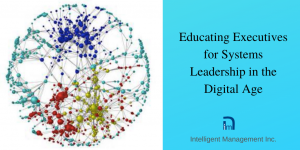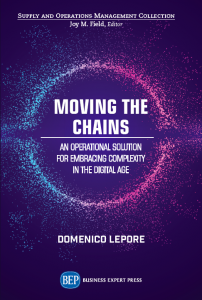
The Managing Director of the World Economic Forum recently published an article called ‘Why the World Needs Systems Leadership, Not Selfish Leadership’
The article concludes:
The self-important don’t always win. Selfless leadership can create systemic change that spreads happiness – instead of hoarding it.
At Intelligent Management we have been educating executives to be Systems Leaders for over 20 years. The following is an excerpt from the new book by our Founder Dr. Domenico Lepore called Moving the Chains.
Leading with Knowledge and Intelligence
For leaders to lead in a systemic way with knowledge, they must have appropriate methods and tools. These methods and tools must be completely in line with the systemic essence of an organization; they cannot be separate (or contradictory). They can have a technical content but they cannot be techniques; they must be a direct emanation of a way of thinking. Moreover, they should enhance and increase people’s systemic intelligence through their use.
When presented with some sort of “Quality improvement toolkit,” Dr. Deming was almost invariably dismissive as he perceived them as either unnecessary or conceptually wrong. Apart from a tepid endorsement of the Ishikawa diagram for cause–effect analysis, Deming only relied on predictive statistics studies (SPC) and its natural companion, the Process Improvement Chart, at the time simply called Control Chart.
Why is process improvement and managing variation through SPC so important? Leaders and managers need to be able to make rational decisions about their organizations, and the work of their organizations consists of processes. Therefore, managers should know how processes behave, both now and in the future. Whether they are aware of it or not, all processes are affected by variation.
Why should an executive go to the trouble of understanding the statistical behavior of any process? To understand this fully, we have to make a distinction between forecasting and predicting. Executives may be asked to make forecasts, and these are empirical suppositions based on previous evidence and, in many cases, fears and hopes. The usefulness of such forecasts is limited, and reliance on them perpetrates a totally inadequate empirical approach to management. Executives, instead, need to be able to predict how any given process will behave in the future as a result of their decisions. This prediction must be grounded in statistical understanding and the epistemological stance it portrays. Statistical Predictability means that the process oscillates “predictably” within its upper and lower limits of variations. This is the only kind of prediction that leaders and managers can reasonably make and the only one that gives rational value to their decisions, as opposed to management based on hunches.
SPC and process improvement charts are indeed the very backbone of any systems-building exercise as they provide insight, not just numbers. (See Step 3 of the Decalogue methodology in Chapter 3.) SPC shelters us from the risk of “linear thinking”; it avoids the mental trap of spreadsheet-fueled, deterministic calculations that are blindsided to speed of flow and systemic implications. Indeed, when properly absorbed and used, SPC is never a technique; it is, as Dr. Deming has said, a way of thinking.
Moreover, seeing systemic implications opens us up to understanding the importance of collaboration beyond the boundaries of our own organizations.
Leading with Critical Chain
Statistical predictability in the processes making up an organizational system facilitates greatly the creation of a network of projects. We can create this network by leveraging the power of the finite capacity scheduling underpinned by the Critical Chain approach to managing projects.
Critical Chain represents the embodiment of a vision of the organization based on pace of flow, people’s involvement, and great emphasis on quality. Quality, involvement, and flow are the basic philosophical pillars of the systemic organization, so Critical Chain plays a major role in the building of an intrinsically systemic organization.
Organizations that are functional/hierarchical grids are clearly inadequate because of their inability to fully support, measure, and promote intrinsically cross-functional activities. They trap the potential of their people into silos. The solution is to design organizations as a network of interdependent projects that work together to achieve the goal of the organization. The allocation of people to tasks according to their skills and level of competency unlocks their potential. It produces an effective use of the resources available, a more ethical consideration of people’s capabilities, and allows us to unleash the power provided by the “intelligent” implementation of project management. Critical Chain enables all this to happen methodologically and practically.
When we combine Critical Chain with the use of SPC, we equip leaders with a “dashboard” that enables them to have real-time monitoring and control of what is going on inside their organization, allowing them to understand what really matters: the state of the Project Buffers.
Designing organizations as networks of projects is not just important for organizations as individual entities; it equips them structurally, operationally, and cognitively to optimize their interactions with larger networks of value.
Schedule an introductory call with us ‘






Leave a Reply